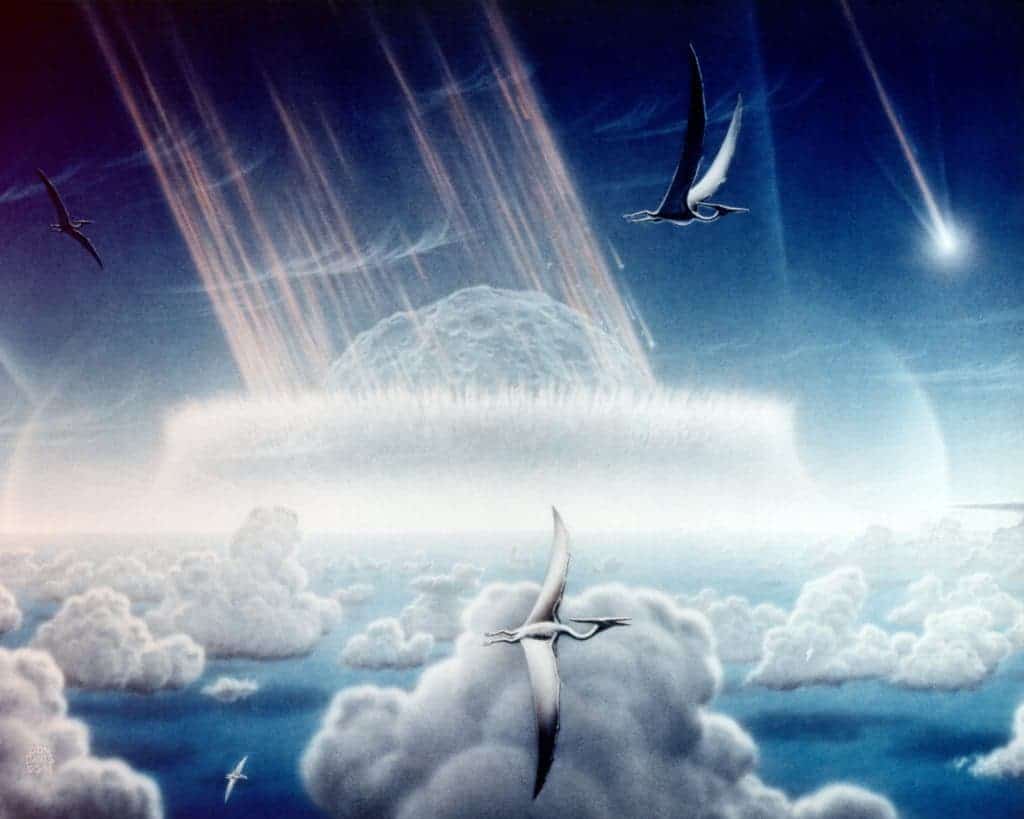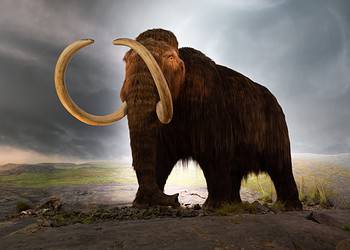
One gloomy day, about 66 million years ago, disaster struck our planet. That day, an asteroid hit offshore Mexico’s Yucatan peninsula with the force of 10 billion Hiroshima A-bombs. In the wake of the devastating impact, 75% of all animal and plant species became extinct — including all non-avian dinosaurs.
Now, scientists have reconstructed the horrendous first 24 hours that created the massive 180-kilometer-wide Chicxulub crater in Mexico. Immediately, the impact triggered wildfires, huge tsunamis, and released millions of tons of sulfur that blocked the sun, eventually leading to global cooling.
This tragic event has remained etched permanently in the planet’s geological history, through a band called the K-T Boundary, which separates the Cretaceous and Tertiary periods in geologic history.
Oddly enough, the crater was discovered only twenty years ago. Previously, scientists called to attention a thin layer of iridium that could be found in rocks all over the world and dated around the time of the dinosaurs’ demise. This material is extraterrestrial, typically found in asteroids, but also in some volcanic ejections. In 1991, Alan Hildebrand, a geologist at the University of Calgary in Canada, found shocked quartz and a layer of iridium-enriched dust in samples collected in the 1950s by Mexican geologists looking for oil at the Chicxulub, and this ultimately led to finding the crater.
In the 25 years since the asteroid’s impact point was identified, scientists have learned a lot about how this event altered the planet.
In 2017, British researchers at Imperial College London estimated that the asteroid collision released about 325 gigatons of sulfur and 425 gigatons of carbon dioxide into the atmosphere, more than 10 times global human emissions of carbon dioxide in 2014. The asteroid crashed into the Earth with the explosive force of 40,000 US nuclear warheads, all triggered in a matter of seconds.
According to that study, Earth’s average surface air temperature dropped by as much as a staggering 26 degrees Celsius (47 degrees Fahrenheit). The sub-freezing temperatures persisted for over three years — enough to destroy plant life and everything else up the food chain.
But the most grueling moments were right after the impact. Writing in the journal Proceedings of the National Academy of Sciences, researchers have reconstructed the timeline of the first day of the dinosaurs’ doom.
The team led by Sean P. S. Gulick, a marine geophysicist at the University of Texas at Austin, utilized high-resolution photography, microscopy, computed tomography imaging and magnetic measurements of sedimentary rock recently recovered from Chicxulub.
Geologists read sediment layers like pages in a history book. Normally, a few centimeters of rock corresponds to a couple thousand years. What scientists recovered at Chicxulub is a 130-meter layer for a single day — imagine the scale of destruction unleashed by the killer asteroid.
“We fried them and then we froze them,” Gulick said in a statement. “Not all the dinosaurs died that day, but many dinosaurs did.”
At ground zero, the asteroid initially carved a 100-km-wide (60-mile), 32-km-deep (20-mile) hole and catapulted rock into the sky with such force that some of it must have reached the moon. Immediately, a huge tsunami was triggered moving radially away from the crater. But half an hour later, the water started moving in the opposite direction, back into the crater, flooding it with debris.
“Most of the material that filled the crater within hours of impact was produced at the impact site or was swept in by seawater pouring back into the crater from the surrounding Gulf of Mexico,” the researchers explained. “Just one day deposited about 425 feet of material — a rate that’s among the highest ever encountered in the geologic record.”
Besides tsunamis and an apocalyptic cloud of sulfur that rained molten rock, the asteroid impact also triggered massive forest fires across the globe. This is evidenced by charcoal in the peak ring above the tsunami layer.
“This suggests that the charred landscape was pulled into the crater with the receding waters of the tsunami,” the researchers noted.
In the future, the researchers plan on studying more potential pieces of evidence from the immediate aftermath of the impact in order to better reconstruct the early hours of dinosaur doom.






